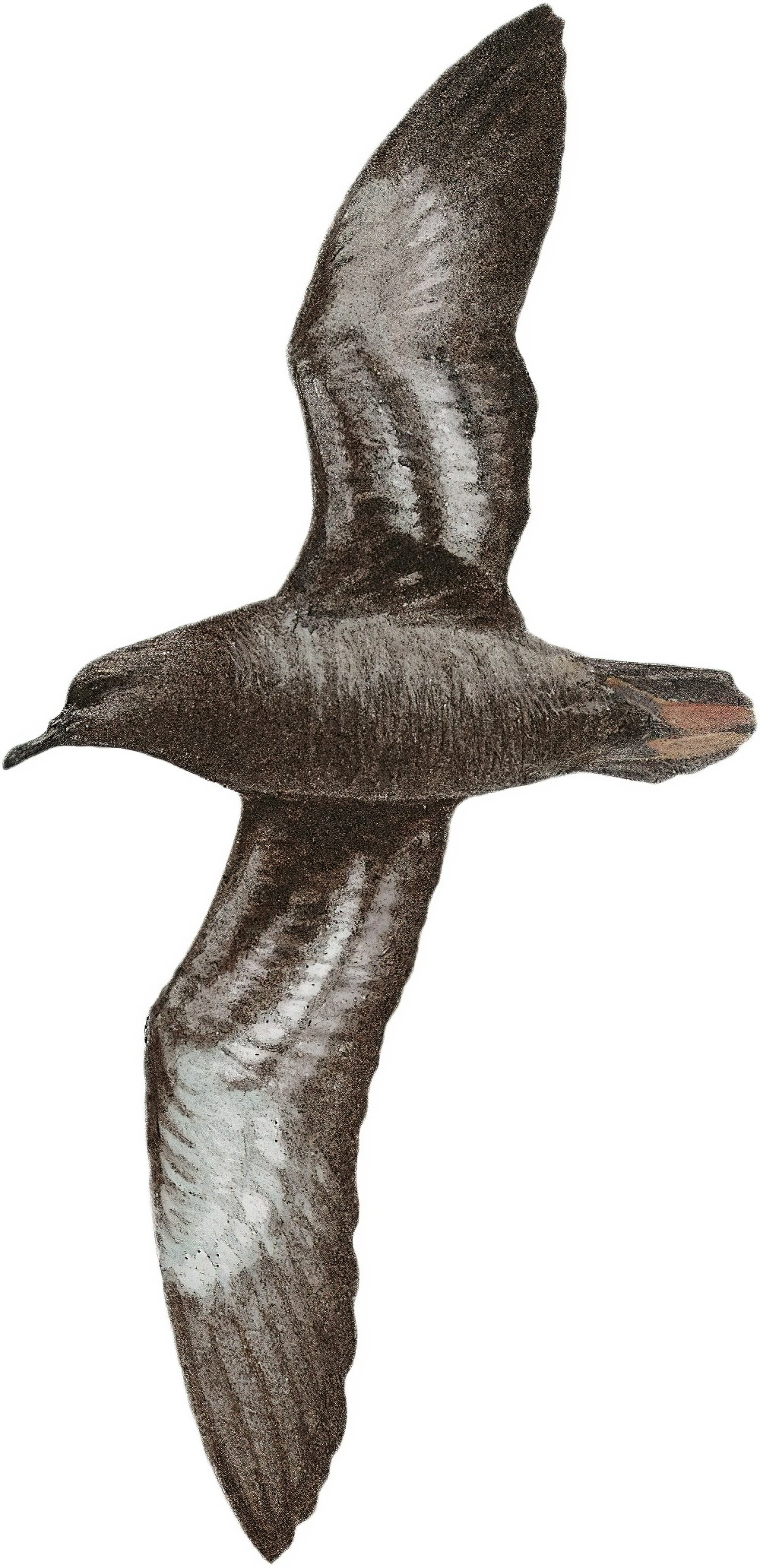Sooty Shearwater / Ardenna grisea

Sooty Shearwater
SCI Name:
Protonym: Procellaria grisea Syst.Nat. 1 pt2 p.564
Taxonomy: Procellariiformes / Procellariidae / Ardenna
Taxonomy Code: sooshe
Type Locality: Southern Hemisphere between 35° S. and 50° S. - New Zealand, as designated by Mathews, 1912, Birds Australia, 2, p. 95.
Author: Gmelin, JF
Publish Year: 1789
IUCN Status: Near Threatened
DEFINITIONS
ARDENNA
(Procellariidae; † Great Shearwater A. gravis) Late Med. L. Ardenna name given to the Diomedean birds (Aldrovandus 1603) (Ray 1678, has "Artenna"). According to Capponi 1979, Ardènna and Artènna are Italian dialect names (based on ardea) for a shearwater; "Genera et Species typicae. ... c. *Ardenna Aldrov. maior (Puff. — Faber) Rchb. Ic. Av. t. 14. ic. 770 et 768—69." (Reichenbach 1853); "Ardenna Reichenbach, Av. Syst. Nat., 1852 (1853), p. iv. Type, by original designation, Puffinus maior Faber = Puffinus gravis O'Reilly." (Peters, 1931, I, 53); "Ardenna Reichenbach, Av. Syst. Nat., p. iv, 1852 (1853)—type, by orig. desig., Puffinus major Reichenbach (not of Faber [= Puffinus puffinus]) = Procellaria gravis O'Reilly." (Hellmayr and Conover, 1948, Cat. Birds Americas, Pt. I (2), p. 63).
Synon. Hemipuffinus, Neonectris, Paranectris, Thyellodroma, Thyellus.
grisea
Med. L. griseum, griseus or grisius grey.
● ex “Dark Grey Petrel” of Cook 1777, and “Grey Petrel” of Latham 1785 (Ardenna).
● ex “Crabier de Cayenne” of d’Aubenton 1765-1781, pl. 908 (syn. Butorides striata).
● ex “Calidris grisea” of Brisson 1760, “Maubèche grise” of d’Aubenton 1765-1781, pl. 366, and “Grisled Sandpiper” of Latham 1785 (syn. Calidris canutus).
● ex “Tourterelle de Cayenne” of Holandre 1790 (syn. Columbina minuta).
● ex “Grimpereau gris de la Chine” of Sonnerat 1782 (?syn. Dicaeum sp., ?syn. Orthotomus sp.)
● ex “Alouette grise de Gingi” of Sonnerat 1782 (Eremopterix).
● ex “Grisin de Cayenne” of d’Aubenton 1765-1781, pl. 643, figs. 1, 2, and “Grisly Warbler” of Latham 1783 (Formicivora).
● ex “Grignet” of Levaillant 1803, pl. 126 (syn. Parisoma subcaeruleum).
● ex “Matuitui” of Willughby 1676, “Numenius americanus minor” of Brisson 1760, “Matuitui des rivages” of de Buffon 1770-1783, and “Grey Ibis” of Latham 1785 (syn. Theristicus melanopis).
● ex “Merle gris de Gingi” of Sonnerat 1782, and “Grey Thrush” of Latham 1783 (syn. Turdoides affinis).
● ex “Tangara olive de la Louisiane” of d’Aubenton 1765-1781, pl. 714, fig. 1, “Gris-Olive” of de Buffon 1770-1783, and “Grey Tanager” of Latham 1783, and Pennant 1785 (syn. Vireo griseus).
● ex “Cotinga gris de Cayenne” of d’Aubenton 1765-1781, pl. 699 (?syn. Xipholena punicea).
● ex “Martin Gris-de-Fer” of Levaillant 1801, pl. 95, fig. 2 (Gracula artefact).
● ex “Avis gonambucho Americana” of Seba 1734, “Bruant de Surinam” of Brisson 1760, “Gonambouch” of de Buffon 1770-1783, and “Grey Bunting” of Latham 1783 (unident.).
● ex “Grey-necked Fly-catcher” of Latham 1783 (unident.).
● ex “Coquantototl, avicula cristata, forma passeris” of Seba 1734-1765, “Manacus cristatus griseus” of Brisson 1760, and “Grey Manakin” of Latham 1783 (unident.).
● "Sporophila intermedia Cabanis ... Loxia grisea Gmelin (Syst. Nat., 1, [2], p. 857, 1789) was long used for the above species. The name rests exclusively upon "Le Gros-Bec de Virginie" Daubenton, Pl. Enl., pl. 393, fig. 1, called by Buffon "Le Grisalbin." The rather poor figure shows a blackish bill, white throat, and whitish superciliaries, and I am inclined to agree with Chubb (Bull. Brit. Orn. Cl., 41, p. 35, 1920) that the name is better dropped as undeterminable." (Hellmayr 1938, XIII, 176) (unident.).
UPPERCASE: current genus
Uppercase first letter: generic synonym
● and ● See: generic homonyms
lowercase: species and subspecies
●: early names, variants, mispellings
‡: extinct
†: type species
Gr.: ancient Greek
L.: Latin
<: derived from
syn: synonym of
/: separates historical and modern geographic names
ex: based on
TL: type locality
OD: original diagnosis (genus) or original description (species)












